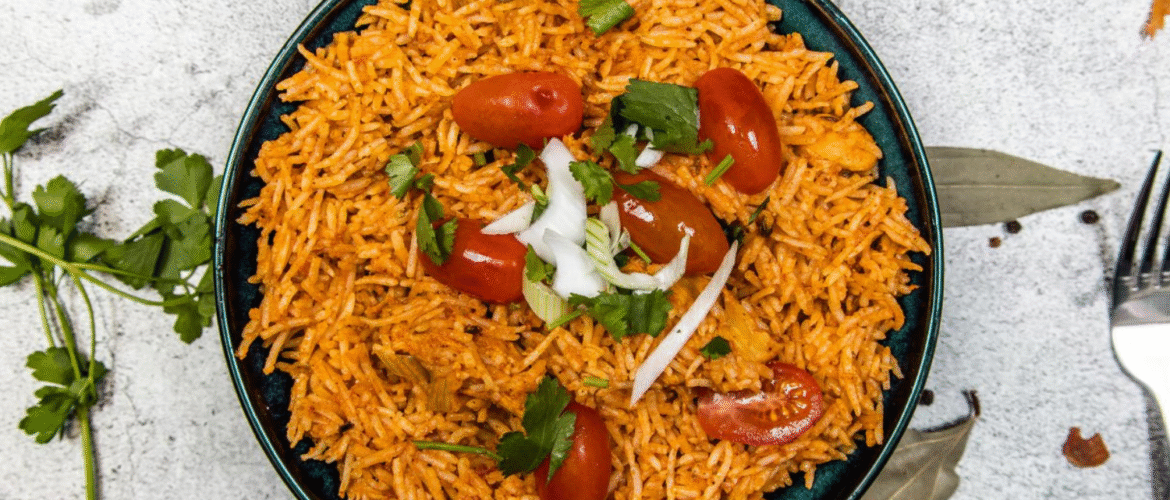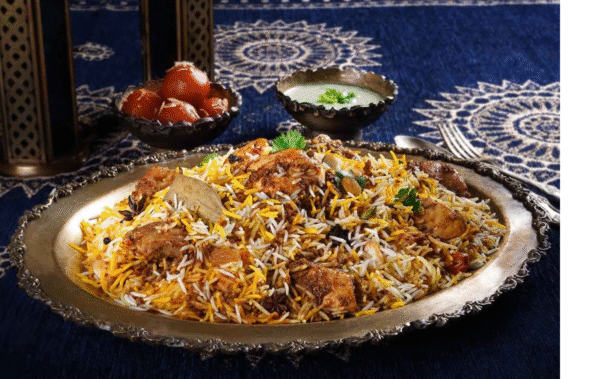No products in the cart.
Royal Chicken Biryani Recipe: A Flavorful Journey Through Spice and Aroma

Introduction
Few dishes in the world command the same reverence and universal love as Chicken Biryani. This non-vegetarian masterpiece is more than just food — it’s a celebration of culture, heritage, and flavor. With origins tracing back to Persian influences that melded beautifully into Indian culinary traditions, biryani has evolved into countless regional variations, each more delicious than the last.
The marriage of fragrant basmati rice, tender chicken, and a symphony of spices creates a sensory explosion that’s hard to resist. Whether served at grand weddings, festive gatherings, or weekend family dinners, Chicken Biryani holds a special place in the hearts and kitchens of millions.
In this blog, we’ll take you step-by-step through a royal chicken biryani recipe that’s perfect for both beginners and seasoned cooks alike. No shortcuts, no packaged mixes — just an authentic experience packed with flavor and love.
What Makes Chicken Biryani So Special?
Biryani is not your average one-pot meal. It requires patience, layering, and attention to detail. Traditionally cooked using the dum method (slow cooking with steam), each layer — from marinated chicken to saffron-kissed rice — is carefully placed and sealed to trap all the moisture and aroma.
Unlike fried rice or pulao, biryani is cooked in stages and involves marinating the protein, partially cooking the rice, and then combining both to steam together. The outcome? Juicy, spiced chicken nestled in long, fluffy grains of rice that smell like heaven.
Ingredients You’ll Need
For Chicken Marinade:
500g chicken (bone-in or boneless)
½ cup thick yogurt
1 tablespoon ginger-garlic paste
1 teaspoon red chili powder
1 teaspoon turmeric powder
1 teaspoon garam masala
1 tablespoon lemon juice
Salt to taste
For Rice:
2 cups long-grain basmati rice
Water (for boiling)
4 cloves
2 cardamom pods
1 bay leaf
½ cinnamon stick
Salt to taste
For Biryani Masala:
2 large onions, thinly sliced
2 tomatoes, chopped
2 green chilies, slit
½ cup chopped coriander leaves
½ cup mint leaves
½ cup milk with a pinch of saffron (soaked for 10 mins)
2 tablespoons ghee or butter
3 tablespoons oil
Step-by-Step Preparation
Step 1: Marinate the Chicken
In a large bowl, combine chicken, yogurt, ginger-garlic paste, lemon juice, and spices.
Mix well and allow it to marinate for at least 1 hour (overnight for best flavor).
This step infuses the meat with deep flavor and tenderizes it.
Step 2: Cook the Rice
Wash the basmati rice thoroughly until water runs clear. Soak it for 30 minutes.
In a large pot, boil water with salt, bay leaf, cardamom, cloves, and cinnamon.
Add soaked rice and cook until 70% done — the grains should be firm.
Drain and set aside.
Step 3: Prepare the Masala Base
In a deep pan, heat oil and ghee. Fry sliced onions until they’re golden brown and caramelized (this takes 10–12 minutes).
Add green chilies, then tomatoes. Cook until tomatoes are soft.
Add chopped coriander and mint leaves. Stir for a few seconds.
Add the marinated chicken and cook until it’s 80% done. The chicken should be partially cooked as it will finish during dum.
Step 4: Layer the Biryani
In a heavy-bottomed pan or handi, begin layering:
Add a layer of chicken masala at the bottom.
Spread half the cooked rice over the chicken.
Drizzle some saffron milk, a few fried onions, and mint-coriander mix.
Repeat with the remaining rice, saffron milk, and garnish.
Step 5: Dum Cooking (Steaming)
Cover the pot with a tight-fitting lid or seal the rim with dough.
Cook on low flame for 20–25 minutes.
Alternatively, place a tava (flat griddle) beneath the pot to prevent burning.
Let it rest for 10 minutes before serving.
Pro Tips for Perfect Biryani
Use aged basmati rice for longer, fluffier grains.
Avoid overcooking rice — it should be firm so it doesn’t turn mushy while steaming.
Fry onions slowly for sweetness and caramelization.
Use fresh herbs generously — they balance the richness of spices.
Don’t rush the dum stage — this slow cooking brings everything together.
Variations Across India
Hyderabadi Biryani: Uses raw marinated meat cooked in layers with rice (kacchi biryani style).
Lucknowi Biryani: More subtle and fragrant, cooked in the dum pukht style.
Kolkata Biryani: Often includes boiled eggs and potatoes with mild spices.
Malabar Biryani: Features coastal flavors and the use of Kerala’s short-grain rice.
Serving Suggestions
Chicken Biryani is best enjoyed hot and fresh, served with:
Raita – Yogurt mixed with cucumber, onion, or mint for a cooling contrast.
Salad – Onion rings, lemon wedges, and green chilies add a crunchy, tangy touch.
Boiled eggs – Optional but elevates the visual and taste appeal.
Papad or Pickle – A crunchy or spicy side to balance the richness.
Healthier Substitutes
If you’re conscious of your diet but don’t want to compromise on taste:
Use brown basmati rice instead of white.
Replace regular ghee with olive oil or low-fat butter.
Go for skinless chicken breast and low-fat yogurt.
Conclusion: A Regal Treat for All Seasons
Chicken Biryani is more than a dish — it’s a rich culinary tradition passed down through generations. With its roots in royal kitchens and its widespread popularity today, biryani remains a celebration of community, flavor, and passion. The love and effort you put into making biryani always shine through in the final taste.






